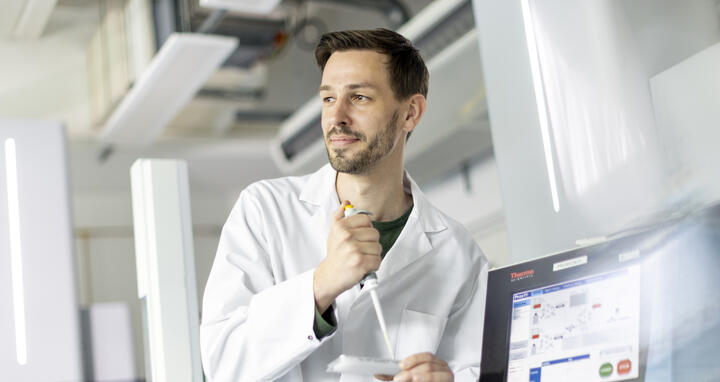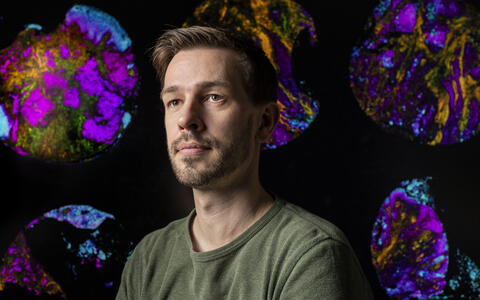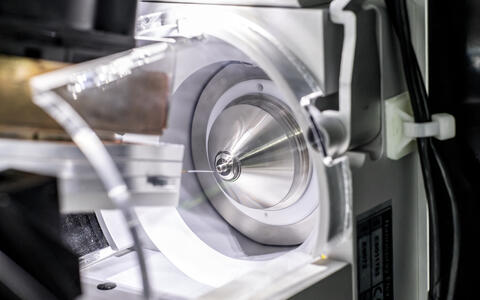The surveyor of cellular proteins
On the screen, the tissue sample looks like a satellite image with countless red, pink, blue and green colored fields. Dr. Fabian Coscia zooms into an area where red cells meet green ones. “This is an exciting region because this is where cells of the head and neck tumor interact with immune cells,” says the biotechnologist, who heads the Spatial Proteomics lab at the Max Delbrück Center. In samples like this, he looks for proteins that could make the difference between life and death.
The 37-year-old Coscia is a technology pioneer. He co-developed a method called Deep Visual Proteomics that combines mass spectrometry with microscopy, artificial intelligence and robotics. He uses this arsenal of combined technologies to hunt for disease-causing proteins. The technology has made it possible to comprehensively measure and analyze thousands of proteins within precisely selected cells – those that exist in the vicinity of tumors, for example. This is a significant advance because it is the proteins that are ultimately responsible for the development and progression of cancer. They are also instrumental in blocking the effect of therapies and consequently, also provide targets for future therapies.
Coscia's path into studying proteins has been mission-like: He earned his doctorate in 2016, formed his own research group in 2021 and was awarded an ERC Starting Grant in 2023 – a rarity for someone his age. A painful family misfortune motivated him to pursue science with determination. “I always wanted to help people. New technologies are only one aspect of achieving this, but an important one.”
Coscia's lab studies proteins. Their complexity is enormous. There are approximately as many protein molecules in a single cell as there are people on earth. “Mass spectrometry is our best tool for capturing this complexity,” Coscia says. Like a scale, it measures the weight of each molecule to uniquely identify it and determine its abundance. The analysis enables researchers to peer into cells to understand important dynamics. “You can uncover mechanisms that you couldn't have guessed beforehand.”
A map of the tumor neighborhood
Coscia combines untargeted discovery proteomics with the targeted nature of microscopy, which he uses to select the most disease relevant cells for analysis. He does this by first introducing antibodies containing fluorescent dyes into tissue samples, which bind to cell surfaces for example, and stains them depending on the cell type. A high-performance scanner then digitizes the sample and deep learning AI software assembles everything into a multi-layered image in which every cell is clearly visible – a map of the tumor microenvironment.
Thanks to artificial intelligence, we notice abnormalities that we would miss with the naked eye.
Tumor cells, active or inactive immune cells or healthy cells can be viewed or hidden with a single click. Coscia can identify regions in the tissue sample where invasive tumor cells are advancing into healthy tissue, for example, or where T-cells are attacking the cancer. “Thanks to artificial intelligence, we notice abnormalities that we would miss with the naked eye,” Coscia says.
Because proteins remain stable for a long time, deep visual proteomics can also screen samples that have been stored in biobanks for many years and map disease progression. “If we know that a group of patients has responded poorly to a therapy, we can see whether certain cells occur more frequently in the tumor environment,” he says. “We can then look for the reasons for resistance in the proteome of these cells and find new therapeutic targets.”
Precisely isolate individual cells
In the laboratory, a doctoral student selects cells on the screen for analysis in the mass spectrometer. A robotic arm separates them from the tissue section using a laser beam. They fall individually into the wells of a microtiter plate. A pipetting robot pierces each cell to access the proteins inside, which are then cut into smaller fragments by specialized enzymes.
The picture shows an interface between a liquid chromatography (LC) and a mass spectrometer (MS). This is the site of electrospray ionization, in which the peptides separated in the LC are electrically charged. These ionized peptides are then transferred to the mass spectrometer, where their mass-to-charge ratios are determined.
Using mass spectrometry, these are fragments charged electrically to determine their molecular weight, Coscia explains. The end result is a long list of numbers that provides information about their identity and abundance. “The measurement is accurate to a millionth, about as accurate as if you were trying to determine whether a bird has landed on the wing of a jumbo jet,” says Coscia.
He has refined, miniaturized and automated his method over the years. “During my doctoral thesis, we still had to measure more than 100,000 cells in a sample. The result was an averaged pattern of all proteins that represented the entirety of these cells.” But it resulted in a lot of important features being overlooked. Now for the first time ever, measurements at the single-cell level are possible.
A protein that drives metastasis
Coscia's hunt for proteins began as a doctoral student at the Max Planck Institute of Biochemistry in Martinsried, where he studied the proteome of ovarian cancer cells. His mentor was Professor Matthias Mann, a pioneer in the field of mass spectrometry-based proteomics. He also studied at the University of Chicago under Professor Ernst Lengyel. Using mass spectrometry, he found a protein in the tumor microenvironment that contributes to metastasis and is associated with a very poor prognosis. “We were able to identify an inhibitor that significantly reduces metastases in a mouse model,” says Coscia. This advance, published in “Nature,” provided the impetus for him to further develop mass spectrometry for high-resolution tissue analysis.
In 2017, Coscia went to Copenhagen to the Novo Nordisk Foundation Center for Protein Research (CPR) at the University of Copenhagen to work on developing deep visual proteomics. His colleague Dr. Andreas Mund contributed microscopy expertise, while Coscia pushed ahead with highly sensitive mass spectrometry. “It was tough, we had to optimize every little step,” Coscia recalls.
In 2020 they obtained their first concrete results. “That's when we realized that it could work.” In August 2022, the method was published in “Nature Biotechnology” to great acclaim. “We now have visits from other labs here at the Max Delbrück Center once a month who want to use deep visual proteomics,” says Coscia. “That is quite rewarding.”
In 2021, Coscia seized the opportunity to set up his own working group at the Max Delbrück Center in Berlin-Buch, as part of the Berlin research core MSTARS, which pools expertise in mass spectrometry and brings it to use in a clinical setting – to study resistance to cancer therapy, for example. His team, which today consists of five doctoral students, a postdoc and a technical assistant, now cooperates with 15 groups at the Max Delbrück Center and Charité – Universitätsmedizin Berlin. Together with clinicians, he is testing his method for analyzing cancer, cardiovascular and neurodegenerative diseases. “We are now in a very exciting phase. After years of developing the technology, the first promising results are coming in.”
Protein hunting gets €1.5 million
Finding the right proteins can save lives in the long term.
Fabian Coscia did not expect his first application for an ERC Starting Grant to be successful. But his proposal was accepted in September 2023. The €1.5 million grant will enable him to further develop the sensitivity and sample throughput of the Deep Visual Proteomics method over five years so that he can hunt for relevant proteins even more efficiently.
His great hope is to track down the molecular signaling pathways that head and neck cancer cells use to suppress the body’s immune response – and to thwart them. This could significantly improve the effectiveness of immunotherapies. “At the moment, immunotherapy is the only way to cure such tumors when chemotherapy no longer responds,” he says. “Finding the right proteins can save lives in the long term.”
Text: Mirco Lomoth









